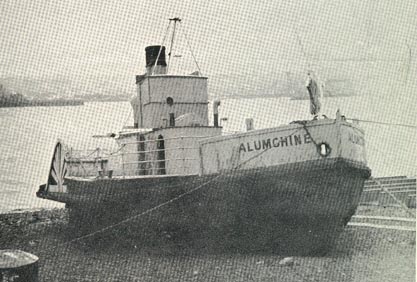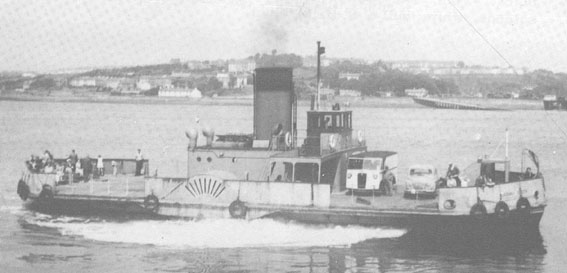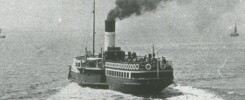
With the introduction of the paddle steamer Cleddau Queen in 1956 for the short Pembroke/Neyland ferry service, the paddle steamer Alumchine, of 1923, became second vessel on the route spending much of her subsequent time in reserve on a buoy in the river and sometimes dried out on the shore.
Plans were in hand for Alumchine to be returned to service on 21st November 1961 to replace Cleddau Queen, which required minor maintenance, when it was discovered that there had been a break-in and a person or persons had tried to damage her steering gear. The police were called but fortunately the damage was not serious and was fairly easily repaired enabling Alumchine to take over from Cleddau Queen as planned.

The Second World War did not of itself bring an end to paddle steamer building. Famous post war examples include of course our own Waverley of 1947 and Maid of the Loch in 1953. But there were others too including Cleddau Queen of 1956 which was originally powered by two steam engines and, like Maid of the Loch, had Board of Trade Class V Passenger Certificates for “Smooth Waters”.
Then there were the Diesel electric paddle tugs Dextrous, Director, Faithfull, Favourite, Forceful, Grinder and Griper built on the Clyde between 1956 and 1958 for service in Royal Naval Dockyards including at Devonport, Gibraltar, Malta, Portsmouth and Rosyth.
Denny of Dumbarton churned out around twenty paddlers in the decade after the war. Two were for the UK market with Farringford of 1947 for the Lymington/Yarmouth ferry service and Sir William Wallace in 1955 for the Firth of Forth. The others included Bhopal, Vigor, Indoric and Mysore in 1945 for service in India; Myngi, Maha, Mindon and Minnan to run on the Irrawaddy River in 1947; Teal, Tern, Irani and Mazbi in 1948 also for service in India; Trenchard in 1950 and, Aberdare, Quorra, James Pinnnock, General Leclerc and Richard Lander in 1951 for Nigeria.
And don’t let us forget the diminutive Charlotte Dundas and Jane Austen built for Commander Wray-Bliss in 1962 and 1966 respectively for running passenger trips on the Kennet and Avon Canal. He favoured the paddle wheel as a means of propulsion as they chomped up any canal weed as they went thereby not allowing it to impede the boat’s progress. All in all that’s quite a lot of post war paddle steamers
But back to Alumchine. She came close to being preserved after she was withdrawn but cold feet in PSPS circles let her slip by even though negotiations, led by the ubiquitous paddle steamer loving Tony McGinnity, were well in hand to acquire her at a knock down price in 1963. In my view Alumchine was an ideal size for paddle steamer preservation. At 80ft LOA and with a crew of just four (like KC) she was small and therefore would have been very economical to maintain and operate. And her flush deck made her more suitable for limited coastal operations on a Class VI Passenger Certificate than KC could ever be with her low freeboard amidships and that dropping away even lower in the bow and the stern. But it was not to be. Alumchine was not saved for us all to enjoy today. Instead she ended up in the scrapyard in 1965 like so many other paddle steamers of that era.
But that lay in the future. On Tuesday 21st November 1961 Alumchine was in service on the Neyland ferry.
Kingswear Castle returned to service in 2023 after the first part of a major rebuild which is designed to set her up for the next 25 years running on the River Dart. The Paddle Steamer Kingswear Castle Trust is now fund raising for the second phase of the rebuild. You can read more about the rebuilds and how you can help if you can here.
John Megoran
This article was first published on 21st November 2020.


